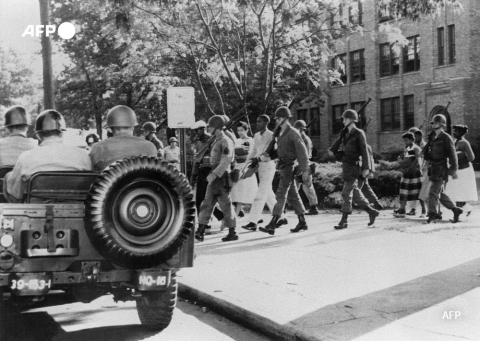A fight to go to school

Nine black students turned up at the Central High School in the city of Little Rock on September 4, 1957 dressed in their Sunday best.
The school had been previously been reserved for whites but the United States had passed a law three years earlier to end such racial segregation.
But, even so, the nine teenagers were met by a mob of whites who were shouting, spitting, throwing stones and calling death threats.
Also present were about 270 soldiers of the National Guard, deployed by the Arkansas state governor, who did not want the black children to enter the school.
A three-week standoff ensued between the state and the White House, which supported the nine students.
President Dwight Eisenhower had to eventually send in troops to escort the teenagers to school.

The Little Rock Nine became symbols of the US civil rights movement and the confrontation, widely covered in the media, drew international attention to racism in the United States.
- Desegregation -
The US Supreme Court abolished racial segregation in public schools on May 17, 1954.
In line with the new law, the National Association for the Advancement of Colored People (NAACP) was registering black students in formerly whites-only schools throughout the conservative South.
But Arkansas Governor Orval Faubus justified his closure of the Little Rock school to blacks on the grounds of public order, saying "blood would run in the streets" should they enter.
He kept the National Guard posted outside throughout the standoff. Fearing for the safety of the Little Rock Nine, civil rights advisers advised them to stay at home.
- President intervenes -
Eisenhower wanted to avoid other states picking up on the defiance and opened talks with the Arkansas authorities.
This led to the students returning to the school on September 23, entering through a side door to avoid attention.
When their presence was discovered, white protesters became violent. They attacked African American bystanders and journalists.
The students were sent home but they returned the next day, this time protected by elite soldiers sent by Eisenhower.
"At a time when we face grave situations abroad because of the hatred that Communism bears toward a system of government based on human rights, it would be difficult to exaggerate the harm that is being done to the prestige and influence, and indeed to the safety, of our nation and the world," the president said.
- Attacks continue -
Elite troops were kept in place until October 1 and then replaced by federal forces.
The following summer governor Faubus decided to close the schools rather than see them go multiracial, a move followed by many other southern districts.
Federal courts ordered that they be reopened, a decision confirmed by the Supreme Court.
The Little Rock Nine continued to face physical and verbal attacks from white students throughout their time at the school.
One of them, Minnijean Brown, fought back and was expelled.
The other eight students remained and in 1958 Ernest Green became the first African American to graduate from Little Rock Central High.
